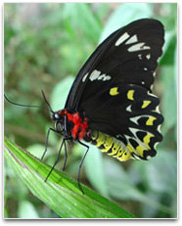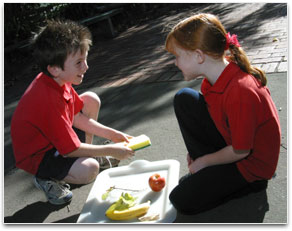This focus idea is explored through:
Contrasting student and scientific views
Student everyday experiences
 For young students things are ‘living’ if they move or grow; for example, the sun, wind, clouds and lightning are considered living because they change and move. Others think plants and certain animals are non-living. An everyday example is that students think various lifecycle stages of a butterfly are not alive (the eggs and immobile pupae), whereas a caterpillar and butterfly can move and are therefore considered to be alive.
For young students things are ‘living’ if they move or grow; for example, the sun, wind, clouds and lightning are considered living because they change and move. Others think plants and certain animals are non-living. An everyday example is that students think various lifecycle stages of a butterfly are not alive (the eggs and immobile pupae), whereas a caterpillar and butterfly can move and are therefore considered to be alive.
There are some difficulties due to the way words such as ‘living’, ‘plants’ and ‘animals’ are used in everyday speech. Students understand ‘living’ in relation to where and how people ‘live’, for example ‘ living in my house’, ‘a dog lives in a kennel’. The students focus on the activity that takes place within a location. Students often do not recognise that trees, vegetables and grass are plants because one everyday use of the word ‘plant,’ refers to small, decorative plants in gardens and nurseries.
Most students list only vertebrates , particularly mammals as animals. Primary students use criteria such as number of legs, body covering and habitat to determine ‘animal’. Some children think animals live only on land.
It is common for 5-7 year old students to have no conception of humans as animals. Often students use ‘animals’ as a term to distinguish between people and animals. This understanding may be further reinforced by common language use, for example signs that read ‘no animals on freeway’ and statements like ‘time to feed the animals’ when referring to family pets.
As students gain knowledge of biological groups such as reptiles, insects and various types of worms, they lose the inclusive ‘animal’ concept. Young students aged 5-6 yrs are more likely to think of spiders and worms as animals (a biologist’s view) than are students aged 9-10.
Research: Bell (1981) (1993), Bell & Barker (1982), Mintzes, Trowbridge, Arnaudin & Wandersee (1991), Fleer & Hardy (1996), Leach, Driver, Scott & Wood-Robinson (1995), Carey (1985), Stepans (1985), Kerr, Beggs & Murphy (2006), Osborne & Freyburg (1985), Murphy (1987)
Scientific view
Living things may be distinguished from non-living things in their ability to carry on life processes such as movement,
respiration, growth, responsiveness to environmental stimuli and reproduction. This view of living may be appropriate at this age but has some limitations and can lead to the alternative conceptions above. For example movement in plants is not apparent to students and consequently they may not consider plants living.
Decisions about whether things are alive or non-living remain problematic as not all life processes stop at the same time. For example, human organs like the heart and lungs, can remain viable for transplant after being outside the body for four to six hours, while the liver and kidneys can be viable for even longer periods.
Critical teaching ideas
- Most living things need food, water, light, temperatures within certain limits, and air.
- Living things have a variety of characteristics that are displayed to different degrees: they respire, move, respond to stimuli, reproduce and grow, and are dependent on their environment.
Research:
Skamp (2004)
 Explore the relationships between ideas about living things in the
Concept Development Maps – (Cell Functions, Variation in Inherited Characteristics, DNA and Inherited Characteristics, Flow of Energy in Ecosystems, Flow of Matter in Ecosystems, Natural Selection)
Explore the relationships between ideas about living things in the
Concept Development Maps – (Cell Functions, Variation in Inherited Characteristics, DNA and Inherited Characteristics, Flow of Energy in Ecosystems, Flow of Matter in Ecosystems, Natural Selection)
To build up a concept of living things focus on the similarities shared with unlike living things. For example, compare ‘a gum tree and a yabby’ rather than always referring to the differences which can be easily identified. Concentrating on differences alone does not encourage students to make connections across ideas or groups, such as seeing that ‘plant’ is a major category of classification not just a label for a type of ‘plant’ in a nursery. There is a need to maintain a focus on the big ideas (such as groups of classification) and allow students to make connections between individual examples and the big ideas.
Research:
Skamp (2004)
It is not simple for teachers to determine how to disprove the idea that fire is ‘alive’. Children tend to think fires are living because they consume wood, move, require air, reproduce (sparks cause other fires) and give off waste (such as smoke). This is a complex idea and is better dealt with at higher levels where concepts can be unpacked in more sophisticated ways. Hence it is not necessary to try to change these conceptions at this stage, but to recognise that students may hold and maintain this view at some stage as learners.
Research:
Kyle, Desmond, Family & Shymansky (1989) ,
Skamp (2004)
Teaching activities
Collect evidence and data for analysis and open up discussion via shared experiences
 Students collect objects from the schoolyard on a scavenger hunt and classify them into groups of their choosing. Students will articulate their classification system. Teachers can then use this discussion to open up issues such, ‘Is it alive?’, ‘Was it ever alive?‘ Such a discussion can elicit student ideas and highlight the difficulties associated with determining if objects are living. Further discussion ideas could include a leaf that has just been picked, a fresh apple etc. Students could take digital photos and create a montage.
Students collect objects from the schoolyard on a scavenger hunt and classify them into groups of their choosing. Students will articulate their classification system. Teachers can then use this discussion to open up issues such, ‘Is it alive?’, ‘Was it ever alive?‘ Such a discussion can elicit student ideas and highlight the difficulties associated with determining if objects are living. Further discussion ideas could include a leaf that has just been picked, a fresh apple etc. Students could take digital photos and create a montage.
 Of the 19 experts who responded to students’ letters on the question of ‘Is a picked tomato alive?’, 17 took the view that the picked tomato was not alive. A good case could be argued that the freshly picked tomato is alive because it is able to maintain its biological integrity for a considerable period of time after picking; i.e. it could change colour from green to red if placed in the sun (as a growing tomato would do) and both would eventually show signs of water loss and decay (at different rates). This provides good content for an interpretive discussion requiring students to use reasoning to justify their arguments because the answer is not clear cut; different opinions are likely and the discussion will open up a range of questions and relevant issues.
Of the 19 experts who responded to students’ letters on the question of ‘Is a picked tomato alive?’, 17 took the view that the picked tomato was not alive. A good case could be argued that the freshly picked tomato is alive because it is able to maintain its biological integrity for a considerable period of time after picking; i.e. it could change colour from green to red if placed in the sun (as a growing tomato would do) and both would eventually show signs of water loss and decay (at different rates). This provides good content for an interpretive discussion requiring students to use reasoning to justify their arguments because the answer is not clear cut; different opinions are likely and the discussion will open up a range of questions and relevant issues.
Research:
Skamp (2004)
Challenge some existing ideas
Other questions to explore could be whether a computer which is turned on is alive; whether a hibernating bear is alive; and whether a deciduous tree in winter is alive. Consider listing key questions that arise in relation to this issue or review these ideas over time with students.
Research :
Skamp (2004)